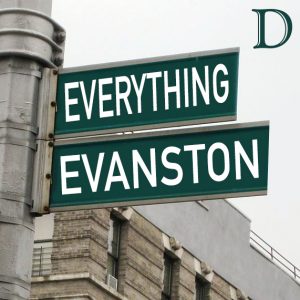5th Ward residents reflect on impacts of waste transfer station with upcoming air quality study
Kalen Luciano/The Daily Northwestern
Chief Sustainability and Resiliency Officer Kumar Jensen spoke about the upcoming air quality study on the 5th Ward waste transfer station.
November 26, 2019
The first night she slept in her new townhouse in Church Street Village, Cindy Levitt woke up to rumbling. Her bedroom was shaking. She thought it was an earthquake. But she soon found out that the rumbling came from trucks rolling into the waste transfer station in her backyard.
Since that first night in 2008, Levitt has dealt with a variety of issues stemming from Advanced Disposal’s waste transfer station, including poor air quality and loud noises. After years of fighting against the station, Levitt and her neighbors will finally gain insight into the impacts of the station when Evanston releases the results of a six-month long air quality study on Dec. 9. The study will include a full analysis of the results as well as recommendations for the future of the site.
A waste transfer station is a facility where trucks dump trash to be stored until a larger truck comes to pick it up and bring it to a landfill. Ald. Robin Rue Simmons (5th) said the station, which is in her ward, is likely there because the neighborhood immediately around it had lower land values. The 5th Ward has the highest concentration of black residents in Evanston, and the station is an example of redlining practices which perpetuate housing inequality, Rue Simmons said.
“I’m not feeling particularly positive about the study just based on all of the other environmental matters that will impact the areas that are being tested,” Rue Simmons said. “My hope is that with this outcome, we can get recommendations on improved initiatives and actions in our neighborhoods to improve our air quality.”
The air quality study, which concluded testing in November, measured pollutants from the station and incorporated a 30-day traffic study to determine the impact of local traffic patterns from the waste transfer station.
Though the neighbors surrounding the station have experienced noise disturbance, traffic, rodent issues and odor issues, the city has not studied the environmental impacts until now
“We don’t know what’s in it. We don’t know how it’s affecting us,” said Dorothy Headd, who lives near the waste transfer station. “We’re hoping we find out. But we don’t know what we’re breathing.”
But the impacts of the station weren’t always so prevalent. It first started as a small, local, family-owned business. Under that ownership, people in the community mostly brought old furniture or larger objects from their homes to the facility.
Advanced Disposal, an international waste disposal company, currently owns the station, and Veolia, another international company, previously owned it and faced a lot of criticism from the community.
State laws prohibit waste disposal facilities 1,000 feet from residential neighborhoods, but dozens of homes, Mason Park and Evanston Township High School property are all within this radius. Because the station was grandfathered in, it’s exempt from these regulations. Still, Headd said that this wouldn’t happen in other communities.
“It was not something that should have been put in a residential neighborhood,” Headd said. “If this was in North Evanston or South Evanston, it would not have been placed an area like that, but because this is a predominantly black area, we know without a doubt that that is the reason why it got here.”
Headd said companies often come into minority communities and promote the potential business opportunities, but they hide the negative effects. In a community of blue collar workers, It can be particularly hard to protest injustices like the waste transfer station when working full-time jobs or raising children, Headd said.
Janet Alexander Davis, a lifetime resident of the 5th Ward, said she thinks this has a lasting impact on how her neighbors see themselves and the place they live in.
“People don’t really know they have rights,” Alexander said. “They (don’t know) they have a right to a community that’s not full of noise or not full of smells. Why in the world was it placed in an African American community?”
Despite these challenges, Evanston Neighbors United formed in the early 2010s to protest the facility and its negative impacts. In 2011, the group organized a protest in front of the waste transfer station, forcing operations to close. The movement grew, fighting for regulations and joining its efforts with the city to issue fees on the station.
This led to a series of court battles, including one where Veolia sued Evanston in 2011 for issuing a fee of two dollars per ton of waste. Evanston settled the suit and retained $1.26 million of the fees the city collected. Some of these funds went into the air quality study, according to Chief Sustainability and Resiliency Officer Kumar Jensen.
Though the station still stands today, the city passed some regulations to reduce its impact on the neighborhood. The station now uses a masking agent to mitigate the odor, and the facility’s trucks are no longer allowed to loiter on the street.
Headd said she hopes the study pushes their efforts further.
“I really would like to just see them gone. If it was not there, we could have a better neighborhood than we have,” Headd said. “We could build that area up, and it will be more desirable for people coming from outside.”
Email: [email protected]
Twitter: @kalenluciano






